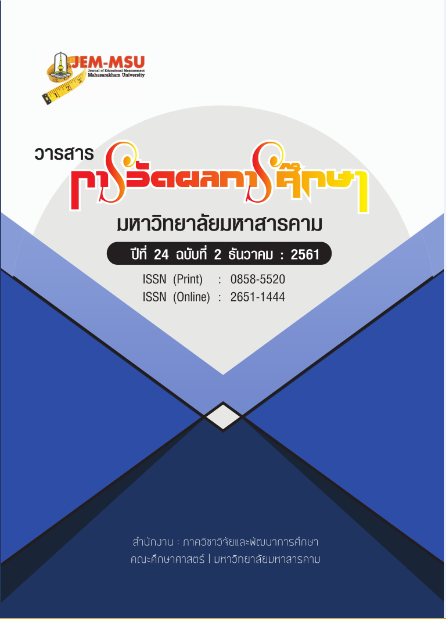The Effects of Working Memory Training Program on Senior High School Students
Main Article Content
Abstract
This research aimed to study the effects of the working memory (WM) training program on senior high school students. The sample consisted of 50 11th grade students in the academic year 2017, in Nikhomwittaya School, Nikhom Phatthana District, Rayong Province, who voluntarily participated in the project and were able to take part in the activities throughout the experiment. The sample was obtained by using random assignment and matching into two groups; each group consisted of 25 students. The experimental group had 25 students, and so did the control group. The experimental group received the working memory training program, which was designed by the researcher. It consisted of 12 fifty-minute sessions of training to enhance working memory. The training was carried out 3 days a week for 4 weeks. Meanwhile, the control group received the regular teaching. The sample was evaluated on the working memory with a working memory measurement tool, one back task, before and after the experiment. The data analysis employed t-test.
The research findings were as follows:
- The students in the experimental group who received the working memory training program had the posttest mean score on the aspect of correctness of working memory higher than that of the students in the control group, with statistical significance at the .05 level. There were no differences on the other aspect.
- The students in the experimental group who received the working memory training program had the working memory posttest mean score on the aspects of correctness, errors and speed of response higher than the pretest score, with statistical significance at the .05 level.
It could be concluded that the WM training program could enhance the working memory on the aspect of correctness of senior high school students.
Article Details
The content and information contained in the published article in the Journal of Educational Measurement Mahasarakham University represent the opinions and responsibilities of the authors directly. The editorial board of the journal is not necessarily in agreement with or responsible for any of the content.
The articles, data, content, images, etc. that have been published in the Journal of Educational Measurement Mahasarakham University are copyrighted by the journal. If any individual or organization wishes to reproduce or perform any actions involving the entirety or any part of the content, they must obtain written permission from the Journal of Educational Measurement Mahasarakham University.
References
Alloway, T. P., & Gathercole, S. E. (2006). How does working memory work in the classroom?. Educational Research and Reviews,1, 134–139.
Alloway, T. P., Gathercole, S. E., Kirkwood, H. J., & Elli-ott, J. E. (2008). Evaluating the validity of the Auto-mated Working Memory Assessment. Educational Psychology,7, 725–734.
Alloway, T. P. & Alloway, R. G. (2012). Can interactive working memory training improving learning?. Journal of interactive Learning Research, 23: 1-11.
Baddeley, A. D. (2007). Working memory, thought and action. Oxford: Oxford University Press.
Baddeley, A. D. (2012). Working memory: theories, models, and controversies. Annu Rev Psychol, 63,1-29. doi: 10.1146/annurev-psych-120710-100422
Buonomano,D.V., Merzenich, M.M.,1998. Cortical plasticity: from synapses to maps. Annu. Rev. Neurosci. 21, 149–186
Klingberg, T., Fernell, E., Olesen, P. J., Johnson, M., Gu-stafsson, P., Dahlstrom, K., et al. (2006). Computerized training of working memory in children with ADHD-A randomized, controlled trial. Journal of the American Academy of Child and Adolescent Psychiatry, 44, 177–186.


